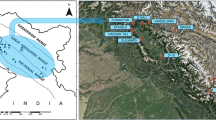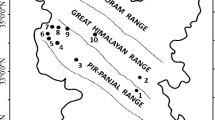Abstract
A numerical avalanche prediction scheme using Hidden Markov Model (HMM) has been developed for Chowkibal–Tangdhar road axis in J&K, India. The model forecast is in the form of different levels of avalanche danger (no, low, medium, and high) with a lead time of two days. Snow and meteorological data (maximum temperature, minimum temperature, fresh snow, fresh snow duration, standing snow) of past 12 winters (1992–2008) have been used to derive the model input variables (average temperature, fresh snow in 24 hrs, snow fall intensity, standing snow, Snow Temperature Index (STI) of the top layer, and STI of buried layer). As in HMMs, there are two sequences: a state sequence and a state dependent observation sequence; in the present model, different levels of avalanche danger are considered as different states of the model and Avalanche Activity Index (AAI) of a day, derived from the model input variables, as an observation. Validation of the model with independent data of two winters (2008–2009, 2009–2010) gives 80% accuracy for both day-1 and day-2. Comparison of various forecasting quality measures and Heidke Skill Score of the HMM and the NN model indicate better forecasting skill of the HMM.

Similar content being viewed by others
References
Agrawal K C and Ganju A 1994 A semi-quantitative approach to avalanche forecasting; Proc. Snow Symposium, pp. 430–439.
Barbec B and Meister R 2001 A nearest neighbor model for regional avalanche forecasting; Ann. Glaciol. 32 130– 134.
Bhatnagar V, Goyal R K, Chaudhury S, Gupta H M, and Mondal D 1994 On avalanche prediction using neighbourhood criterion; Proc. Snow Symposium, pp. 414– 416.
Buser O 1983 Avalanche forecast with the method of nearest neighbors: An interactive approach; Cold Region Sci. Technol. 8 135–163.
Buser O 1989 Two years experience of operational avalanche forecasting using the nearest neighbor method; Ann. Glaciol. 13 31–34.
Buser O, Butler M, and Good W 1987 Avalanche forecast by the nearest method; IAHS Publ. No 162 557–569.
Gassner M, Etter H and Birkelend K 2000 An improved avalanche forecasting program based on the nearestneighbor method; Proc. International Snow Science Workshop, Big Sky, Montana, USA, pp. 52–59.
Gubler H 1982 Strength of bonds between ice grains after short contact times; J. Glaciol. 28 (100) 457– 473.
Hay L, McCabe J, Wolock D M, and Ayers M A 1991 Simulation of precipitation by weather type analysis; Water Resour. Res. 27 493–501.
Hughes J P and Guttorp P A 1994 Class of stochastic models for relating synoptic atmospheric patterns to regional hydrologic phenomena; Water Resour. Res. 30 1535–1546.
Joshi J C, Ganju A and Sharma V 2010 A new approach to avalanche warning over Indian western Himalaya; Curr. Sci. 91(11) 69–72.
Kozak M C, Elder K, Birklend K, and Chapman P 2002 Predicting snow layer hardness with meteorological factors; Proc. International Snow Science Workshop, Penticton, British Columbia.
McClung D M 1994 Use of expert knowledge in avalanche forecasting; Proc. Snow Symposium, pp. 417–424.
McClung D M and Tweedy J 1994 Numerical avalanche prediction: Kootenay Pass, British Columbia, Canada; J. Glaciol. 40(135) 350–358.
Mc Collister C, Birklend K, Hansen K, Aspinall R, and Comy R 2003 Exploring multi-scale spatial pattern in historical avalanche data, Jackson Hole ski area, Wyoming; Cold Region Sci. Technol. 37 (3) 299–313.
Naresh P and Pant L M 1999 Knowledge based system for forecasting snow avalanches of Chowkibal–Tangdhar Axis (J&K); Defense Sci. J. 49 (5) 381–391.
Obled and Good 1980 Recent developments of avalanche forecasting by discriminant techniques: A methodological review and some applications to the Parsenn area (Davos, Switzerland); J. Glaciol. 25 (92) 315–345.
Purves R S, Morrison K W, Moss G, and Wright D S B 2003 Nearest neighbors for avalanche forecasting in Scotland–development, verification and optimization of a model; Cold Region Sci. Technol. 37 (3) 343–355.
Rabiner L R 1989 A tutorial on Hidden Markov Model and selected applications in speech recognition; Proceedings of IEEE 73, No. 2.
Singh D and Ganju A 2008 Expert system for prediction of avalanche; Curr. Sci. 94 1076–1081.
Singh A, Srinivasan K, and Ganju A 2005 Avalanche forecast using numerical weather prediction in Indian Himalaya; Cold Reg. Sci. Technol. 43 83–92.
Zucchini W and Guttorp P 1991 A hidden Markov model for space-time precipitation; Water Resour. Res. 27 1917–1923.
Acknowledgements
The authors acknowledge all data collection teams of SASE for their precious contribution in the collection of valuable snow and meteorological data in the harsh climatic conditions of the Himalayas. Authors would like to give due credit to Sh. Dan Singh who helped in the comparative study of the HMM with the NN model. They also acknowledge their colleagues for valuable technical suggestions and critical comments.
Author information
Authors and Affiliations
Corresponding author
Rights and permissions
About this article
Cite this article
Joshi, J.C., Srivastava, S. A Hidden Markov Model for avalanche forecasting on Chowkibal–Tangdhar road axis in Indian Himalayas. J Earth Syst Sci 123, 1771–1779 (2014). https://doi.org/10.1007/s12040-014-0510-4
Received:
Revised:
Accepted:
Published:
Issue Date:
DOI: https://doi.org/10.1007/s12040-014-0510-4




